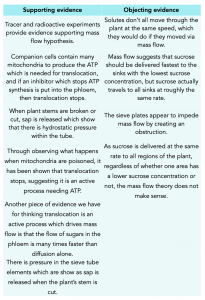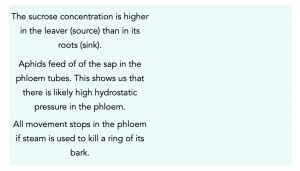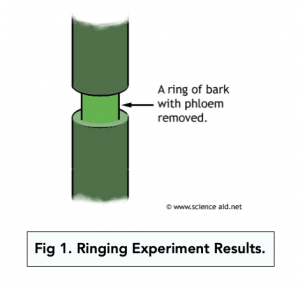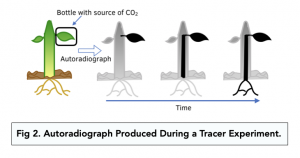Translocation and Evidence of the Mass Flow Hypothesis (A-level Biology)
Translocation is the process used to transport dissolved products in phloem, from an area of the plant which creates the substances in excess to areas where they are needed.
Areas which made these substances, via photosynthesis, are known as sources. Sinks are the areas which need the substances, for example, leaves.
The products made include amino acids and sucrose. Assimilates are the products produced via the process of translocation, which is an energy-requiring, active process. If respirating is inhibited, translocation is impaired.
Due to roots being unable to photosynthesis, it needs to get its carbohydrates from other areas of the plant, such as storage organs.
Phloem cells are made up of two types of cells, sieve tube elements and companion cells, where translocation takes place.
Once sucrose reaches a sink, it is converted into starch for carbohydrate storage, which maintains the concentration gradient between the source and sink to increase movement of sucrose into the source.
Mass Flow Hypothesis
The mass flow hypothesis is the theory which states that mass flow of solutes takes place in the phloem.
Whilst it is not a concrete theory, in the sense that it only attempts to explain how solutes are transported for a source to sinks through the phloem, it is the best theory we currently have based on the evidence available.
The process serves to move a mass flow of water from a source to a sink, down the hydrostatic pressure gradient, to supply assimilates where they’re needed. It is described below:
- Active transport moves sucrose from a companion cell into the sieve tube elements, reducing the water potential inside.
- Osmosis moves water into the phloem, which increases the hydrostatic pressure. The pressure is higher nearer the source cell and lower at the sink cell end.
- Solutes move down the pressure gradient, moving into the sink cells where they are converted into the molecules.
- As the solutes are removed, the water potential near the sink end increases, causing osmosis to move water out of the phloem in order to maintain hydrostatic pressure gradient between the source and sink.
Active Loading
Active loading is the process where sucrose is actively transported into sieve tube elements.
- Companion cells use ATP. In order to move hydrogen ions into the tissue surrounding the phloem, companion cells use ATP (energy).
- Hydrogen ions move back into companion cells. This creates a diffusion gradient and causes the hydrogen ions to diffuse back into the companion cells, which is a form of facilitated diffusion involving co-transporter proteins.
- Hydrogen ions help assimilates enter the cell. Hydrogen ions moving back into the companion cells pass through co-transporter proteins, where assimilates are dropped into the cell as each ion passes, causing the concentration to increase.
- Assimilates diffuse down concentration gradient. This results in the assimilates diffusing out of the companion cells, going down the concentration gradient, where they the enter sieve tube elements through links, known as plasmodesmata.
- Hydrostatic pressure decrease. Once they enter the sieve tube elements, the water potential inside the tube decreases, causing water to enter via osmosis, increasing the hydrostatic pressure in the sieve tube.
- Assimilates removed. As water moves down the sieve tube from a high pressure to low pressure area, diffusion or active transport removes the assimilates into the surrounding cells.
- Sieve tube’s water potential increases. This increases the sieve tube’s water potential, meaning water leaves by osmosis and produces pressure in the phloem at the sink.
Loading Pathways
Sucrose can be loaded into the phloem tissue via the symplast or apoplast pathway.
Symplast pathway:
- Diffusion moves sucrose from a leaf cell to a sieve tube element in a phloem cell. This decreases the water potential, where osmosis moves water into the phloem from the xylem tissue.
- Hydrostatic pressure is created as water moves down the pressure gradient towards the sink.
Apoplast pathway:
- Sucrose moves from a leaf cell to a companion cell wall via diffusion.
- Active transport then moves the sucrose into the cytoplasm, where it can move through the plasmodesmata via diffusion into the sieve tube element.
- Osmosis and hydrostatic pressure move the sucrose towards the sink, where the phloem is unloaded passively.
- The concentration gradient is maintained as the sucrose is removed. This water potential increases as a result, so osmosis moves water out.
Evidence
The evidence we have for the mass flow theory is outlined below:


Some unanswered questions that could be considered a weakness of the theory:
- Why can the movement in sieve tubes be bidirectional?
- Why does movement in the phloem need sieve plates and companion cells alive?
As the table above shows, we have more evidence in support of the mass flow theory than against, which is why it is so widely accepted.
Investigating Transport in Plants
Ringing Experiments
Ringing experiments can be used to find out whether it is the phloem, xylem, or both that is responsible for the translocation of sugars in plants.
The process is as follows:
- Removal of tissue. Remove the outer sections of a woody stem, consisting of the protective layer and phloem tissue, around the complete circumference, whilst it is still attached to the plant.
- Leave and observe. Watch the upper half of the stem, above when the layers were removed, to see swelling (over a week timeframe).
- Fluid levels. By testing the fluid, it can be found that they are high in sugars and other dissolved substances.
- Results. By viewing the whole plant, it can be seen that the area towards the roots, that can’t perform photosynthesis, begin to wither and die, whilst the rest continues growing.
These results can help come to the conclusion that the sugars in the phloem above the ring is the cause of the swelling, and the interruption to the flow of these sugars below the ring is the cause of the death of the tissues.

Tracer Experiments
Tracer experiments can also be used to track the movement of substances in plants. The process is below:
- Controlled plants grow. The environment these plants are grown in contains radioactively labelled carbon dioxide (14CO2) from the isotope 14C.
- Altered sugars. The 14CO2 gets incorporated into the sugar produced during photosynthesis.
- Tracing. This allows the radioactive sugars to be traced, as they move around during translocation, by using an autoradiograph.
- Autoradiography. Placing cross-sections of the plant onto X-ray film will cause the film to become blackened if it gets exposed to radiation produced by the 14C in the sugar.
- Blackened areas correspond to phloem tissue. As other tissues don’t blacken film, it follows that they 14C sugars do, giving an insight into the fact that only phloem are responsible for their translocation.

Translocation in Biology refers to the movement of substances across cell membranes, such as the movement of glucose from the blood into the cells. This process is facilitated by specific transport proteins in the cell membrane.
The Mass Flow Hypothesis is a theory that explains the movement of water and solutes from high to low concentration across a selectively permeable membrane. It states that the movement of water and solutes is driven by a concentration gradient, with the movement occurring from an area of high concentration to an area of low concentration.
There is a wealth of evidence for the Mass Flow Hypothesis, including experiments using osmosis, where water moves from a high concentration to a low concentration through a selectively permeable membrane. Additionally, studies on plant cells have shown that solutes move from the roots to the shoots in response to changes in solute concentration, further supporting the Mass Flow Hypothesis.
Translocation supports the Mass Flow Hypothesis by demonstrating the movement of substances across cell membranes from an area of high concentration to an area of low concentration. The transport proteins in the cell membrane facilitate this movement by allowing the substances to cross the membrane.
The Mass Flow Hypothesis is crucial for the survival and growth of plants, as it helps to explain how water and essential nutrients move from the roots to the shoots and leaves. This movement is necessary for the plant to maintain turgor pressure and regulate its water balance, as well as for the transport of photosynthetic products from the leaves to the rest of the plant.
The Mass Flow Hypothesis applies to other biological systems, such as the transport of substances across the plasma membrane of animal cells and the movement of fluids and solutes across the filtration barrier in the kidneys. In all of these systems, the movement of substances is driven by a concentration gradient, with the movement occurring from an area of high concentration to an area of low concentration.
The Mass Flow Hypothesis is related to other theories of transport across membranes, such as facilitated diffusion and active transport. Facilitated diffusion involves the movement of substances down a concentration gradient, while active transport involves the movement of substances against a concentration gradient using energy from ATP. The Mass Flow Hypothesis provides a framework for understanding the movement of water and solutes across membranes, while these other theories provide a more detailed understanding of the mechanisms involved.






Still got a question? Leave a comment
Leave a comment